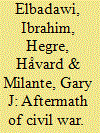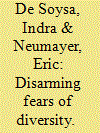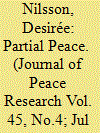|
|
|
Sort Order |
|
|
|
Items / Page
|
|
|
|
|
|
|
| Srl | Item |
| 1 |
ID:
083244


|
|
|
|
|
| Publication |
2008.
|
| Summary/Abstract |
This article introduces the special issue on `The Aftermath of Civil War' and presents the research project from which the articles in this issue originate. The article presents a few empirical observations that demonstrate the increasing importance of the post-conflict situation for actors that engage to reduce the global incidence of armed conflict. The global incidence of conflict was reduced from 1992 to 2002, since there were more terminations than onsets. Although this trend seems to have halted, a scrutiny of the onsets shows that they increasingly are recurrences of conflicts that have been inactive for a period. In 2005 and 2006, there were no new conflicts. The article then briefly introduces the six contributions to the special issue. The articles investigate the importance of peacekeeping troops, elections, aid, capital flight, and exclusion of parties from peace agreements in post-conflict situations. The articles are also applicable to countries that have not had armed conflicts, as the authors investigate the relationship between ethnic diversity and military spending and the determinants of youths' decisions to participate in rebel groups.
|
|
|
|
|
|
|
|
|
|
|
|
|
|
|
|
| 2 |
ID:
083250


|
|
|
|
|
| Publication |
2008.
|
| Summary/Abstract |
This article analyzes negative externalities that policymakers in one region or group may impose upon the citizens of neighboring regions or groups. These externalities may be material, but they may also be psychological (in the form of envy). The latter form of externality may arise from the production of `conspicuous' public goods. As a result, decentralized provision of conspicuous public goods may be too high. Potentially, a centralized legislature may internalize negative externalities. However, in a model with strategic delegation, we argue that the median voter in each jurisdiction may anticipate a reduction in local public goods supply and delegate to a policymaker who cares more for public goods than she does herself. This last effect mitigates the expected benefits of policy centralization. The authors' theory is then applied to the setting of civil conflict, where they discuss electoral outcomes in Northern Ireland and Yugoslavia before and after significant institutional changes that affected the degree of centralization. These case studies provide support for the authors' theoretical predictions.
|
|
|
|
|
|
|
|
|
|
|
|
|
|
|
|
| 3 |
ID:
083247


|
|
|
|
|
| Publication |
2008.
|
| Summary/Abstract |
This study investigates whether ethnic and other forms of social diversity affect militarization of society. Recent scholarship in economics finds that high diversity leads to lower provision of public goods. At the same time, many conflict studies find that highly diverse societies face a lower risk of civil war, as opposed to relatively more homogenous populations. The authors explore whether diversity prompts governments to militarize heavily in order to prevent armed conflict, which would then crowd out spending on other public goods in a `guns versus butter' trade-off. Thus, `preventive militarization' would explain both outcomes. Yet the authors find the opposite: higher levels of ethnic diversity predict lower levels of militarization. If high diversity lowers the hazard of civil war, as many find, then it does not happen via preventive militarization. If diverse societies spend less on public goods, then this is not because they are crowded out by security spending. The results support those who suggest that diversity may, in fact, pose a lower security threat to states, since it is highly likely that states facing potential social strife would prioritize state militarization.
|
|
|
|
|
|
|
|
|
|
|
|
|
|
|
|
| 4 |
ID:
083249


|
|
|
|
|
| Publication |
2008.
|
| Summary/Abstract |
This article attempts to explain the determinants of the probability of willingness to join rebel groups by youths in the Niger Delta region of Nigeria, using primary data from a sample of 1,337 individuals drawn from 18 communities. A cardinal objective is to test the theoretical explanations of the motivation for rebellion in resource-based societies and to examine the kind of factors that present rebel opportunity. Fifteen variables are used to reflect motives and opportunity for rebellion, and a logit regression model is employed to estimate the probability of willingness to participate. While grievance appears to be pervasive among individuals- and is systemically explained by the data, it is not seen to have high statistical effect on the probability of having a disposition to rebel participation. Rather, individual-and community-level factors that reduce the opportunity cost and risk of participation, or increase the perceived benefits, appear to be more important. The findings suggest that strategies to achieve long-lasting civil peace in Nigeria's Delta must go beyond grievance to address individual-level factors that determine the opportunity cost of participation in violence, such as low income level and low educational attainment, and community-level factors that create an opportunity to profit from extreme forms of civil disobedience, such as low infrastructure. Some of these strategies choices are found also to have the potential to address grievance
|
|
|
|
|
|
|
|
|
|
|
|
|
|
|
|
| 5 |
ID:
083246


|
|
|
|
|
| Publication |
2008.
|
| Summary/Abstract |
Previous research proposes that peace is more likely to become durable if all rebel groups are included in the settlement reached. The argument implies that if actors are excluded and continue to pursue the military course, this could have a destabilizing effect on the actors that have signed an agreement. This article argues that all-inclusive peace deals - signed by the government and all rebel groups - are not the panacea for peace that many seem to believe. Given that the parties are strategic actors who are forward-looking when making their decisions, the signatories should anticipate that the excluded parties may continue to fight. Therefore, the risk of violent challenges from outside actors is likely to already be factored into the decisionmaking calculus when the signatories decide to reach a deal, and so does not affect their commitment to peace. Implications from this theoretical argument are tested using unique data on the conflict behavior of the government and each of the rebel groups in internal armed conflicts during the post-Cold War period. The results are well in line with the theoretical expectations and show that whether an agreement leaves out some actor does not affect whether the signatories stick to peace. The results demonstrate that, even when excluded rebel groups engage in conflict, this does not affect the signatories' commitment to peace. Hence, the findings suggest that partial peace is possible.
|
|
|
|
|
|
|
|
|
|
|
|
|
|
|
|
| 6 |
ID:
083248


|
|
|
|
|
| Publication |
2008.
|
| Summary/Abstract |
This article provides empirical evidence on the effects of inflation on postwar capital flight flows. It tests the hypothesis that inflation has a positive differential effect on capital flight in postwar economies. It uses a new panel dataset of 77 developing countries, of which 35 experienced at least one episode of war between 1971 and 2000. The rest enjoyed peace throughout this period. Ordinary Least Squares, Generalized Least Squares, Within-Group and Arellano-Bond estimation methods are applied to four capital flight measures - Cline, World Bank, Morgan Guaranty and Dooley. The results support the research hypothesis: in postwar economies, a percentage point increase in the inflation rate is associated with a differential increase in annual capital flight flows of about 0.005 to 0.01 percentage points of GDP. This constitutes the positive differential impact of inflation on capital flight after war. This finding is robust to alternative specifications of the capital flight equation, the different measures of capital flight and econometric estimation methodologies. Given the average level of capital flight flows and the high and sustained inflation rates in some postwar economies, the overall effect could be substantial. The implication is that low inflation helps to curb capital flight in postwar economies.
|
|
|
|
|
|
|
|
|
|
|
|
|
|
|
|
|
|
|
|
|